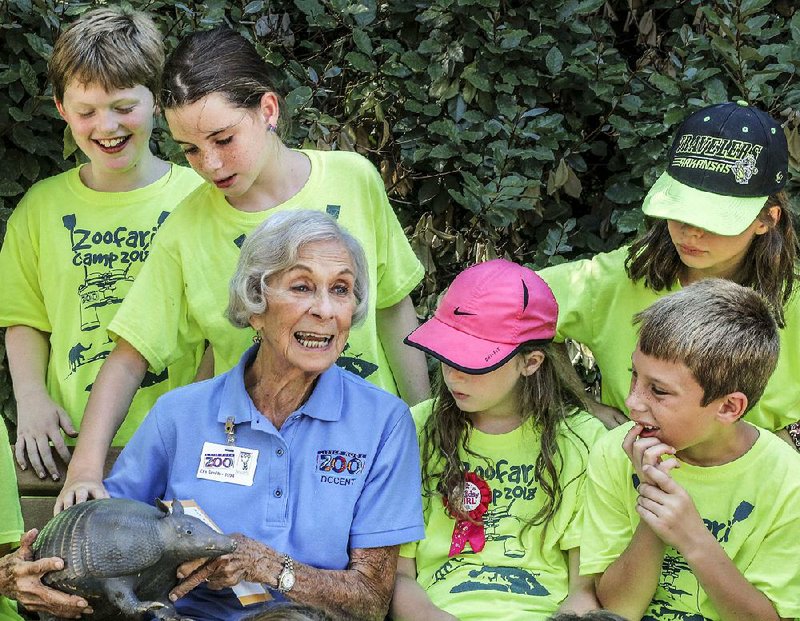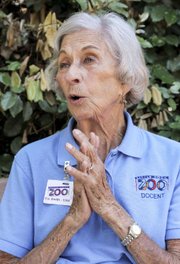Em Smith has been volunteering at the Little Rock Zoo longer than many of the visitors have been alive.
Smith started her volunteer work in 1965. In spring 2017, the other zoo docents named her "Queen of the Kiosk" and gave her the privilege of volunteering any time she wants to.
The kiosk was recently torn down, and so Smith, 95, now sits on a covered bench near the zoo entrance and enchants young visitors with stories about her rattlesnake skin and an armadillo preserved by a taxidermist. She usually volunteers on Tuesday and Thursday mornings but sometimes also comes on Saturdays.
"I've been here a long time," Smith says, reflecting on her days at the zoo. "I've had a really good life."
Susan Harris, docent coordinator and educational office assistant, says Smith is a "vital resource for us." She adds that Smith can provide historical information about the zoo that would otherwise have been lost over time. And she confirms that Smith is the longest serving volunteer at the zoo.
"Even though she is 95, you would never know it," Harris says. "She is sharp and she is a great resource for our program. And the children love her. She's everybody's grandma. We have yet to meet a child who does not love Miss Em."
Harris says there have been many adult guests who ask for Miss Em because they remember her from their childhood visits to the zoo.
Lamor Williams, communications manager for the city of Little Rock, said Smith is one of the longest serving volunteers for a city department.
Her favorite memories of the zoo are from bygone days when the zoo hosted Zoo Days and she exchanged dollars for "monkey money" -- coupons visitors could use to make purchases. She remembers American Indians would dance and sell their wares.
Smith seems cool and comfortable in the hot Arkansas sun. When children start gathering around her, Smith goes into full volunteer mode, asking her little visitors if they want to touch the rattlesnake skin.
"When you hold a snake, you are warm and it stays right there," she tells the children, cradling the snakeskin. "It likes the way you feel."
The rattler was shot a few years ago by a worker at her farm near Tichnor in Arkansas County. Smith explains it is against the law to kill a snake in Arkansas. And she is right.
According to the Arkansas Game and Fish Commission wildlife code, all native snakes, including venomous snakes, are protected by law and are illegal to kill unless they "pose reasonable threat or endangerment to persons or property" on private property.
Smith's rattlesnake has black felt on its backside. She said she never named it because "it doesn't have a head." The armadillo was given to her by the man who killed and preserved it. She says she has had it for at least 30 years. And while the armadillo has a head, she says she never got around to naming it.
She says the armadillo used to have more wiry hair on its sides and belly. The hairs have been rubbed off over the years by children who wanted to pet it.
"The zoo is always glad when a docent has an animal to show to visitors whether it is a live rabbit or owl or a biofact of deceased animals," she says in a letter written to the Arkansas Democrat-Gazette.
She says she transports the snakeskin and armadillo in the back of her car. She tells the story of the time the car was involved in a wreck at a carwash. The carwash attendants did not speak English, and there was apparently a lot of confusion about why she had an armadillo in the car.
Lots of people ask her whether armadillos can spread leprosy. According to Smithsonian.com, armadillos are the only other animal besides humans that can host the leprosy bacillus. But, according to the Smithsonian, leprosy only infects 150-250 Americans a year. And up to 95 percent of the population is not genetically susceptible to contracting it.
More frequently, Smith says, she is asked, "Where's the closest restroom?"
Smith took her two daughters to the zoo when they were young. She doesn't remember exactly why she became a zoo docent, but says she did it after she retired as a dietitian. Her husband, Dr. A. Wade Smith, was an oral surgeon -- now known as a maxillofacial surgeon. The couple were married almost 60 years. He died "way too long ago," she says.
When she is not at the zoo, Smith can be found at the Jim Dailey Fitness & Aquatic Center where she walks in the pool and lifts weights to improve her upper body strength. She says she needs to keep her upper body strong so she can curl her hair.
"I have to roll my hair up," she says with a smile.
Information about the docent program at the Little Rock Zoo can be found at littlerockzoo.com/docentprogram or by calling (501) 661-7229.
High Profile on 08/12/2018

